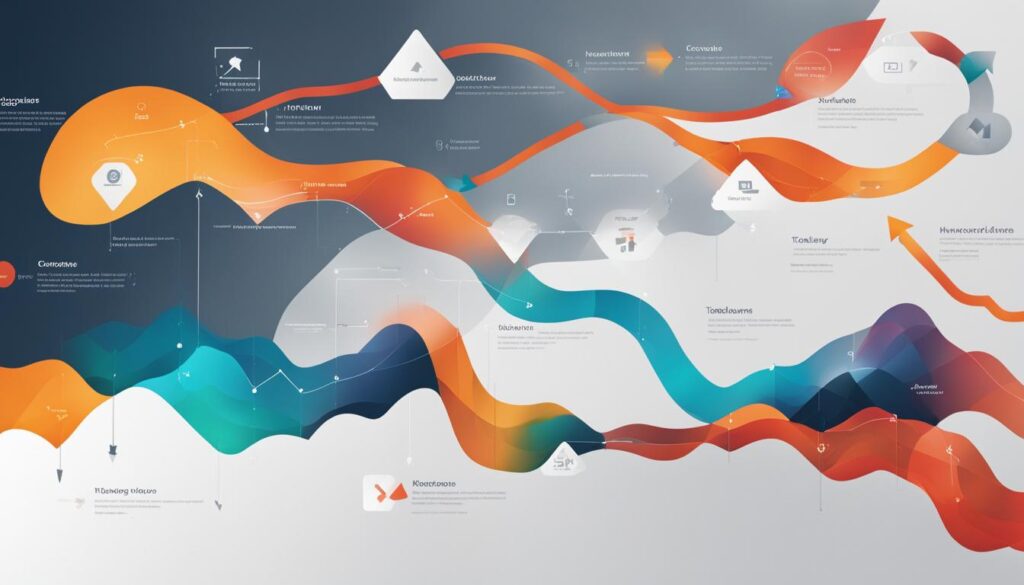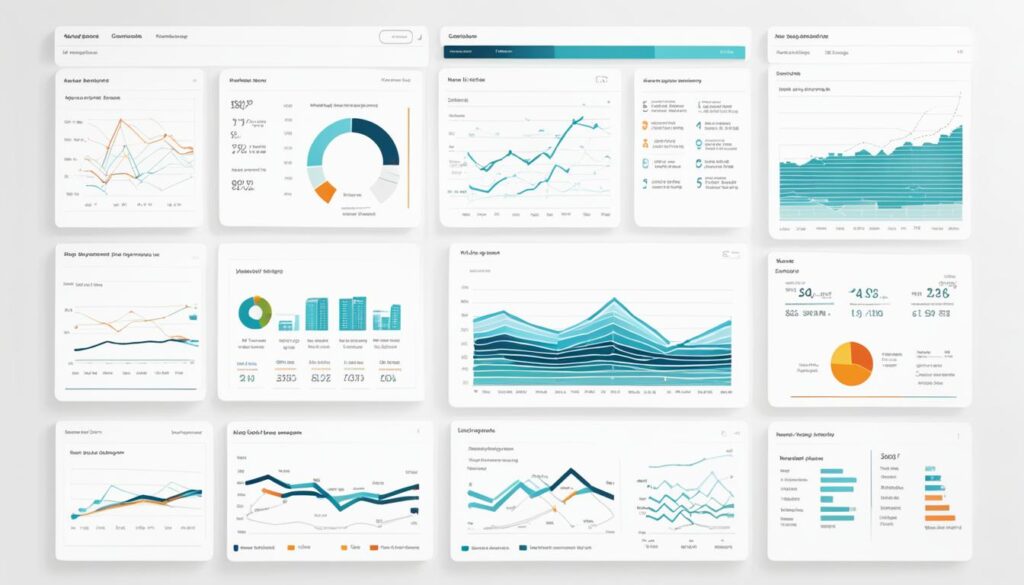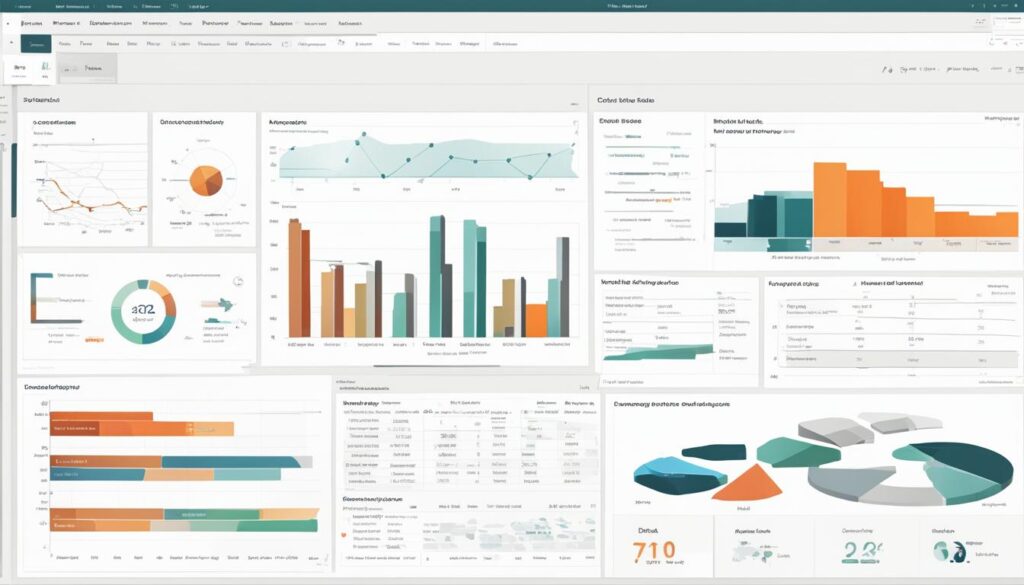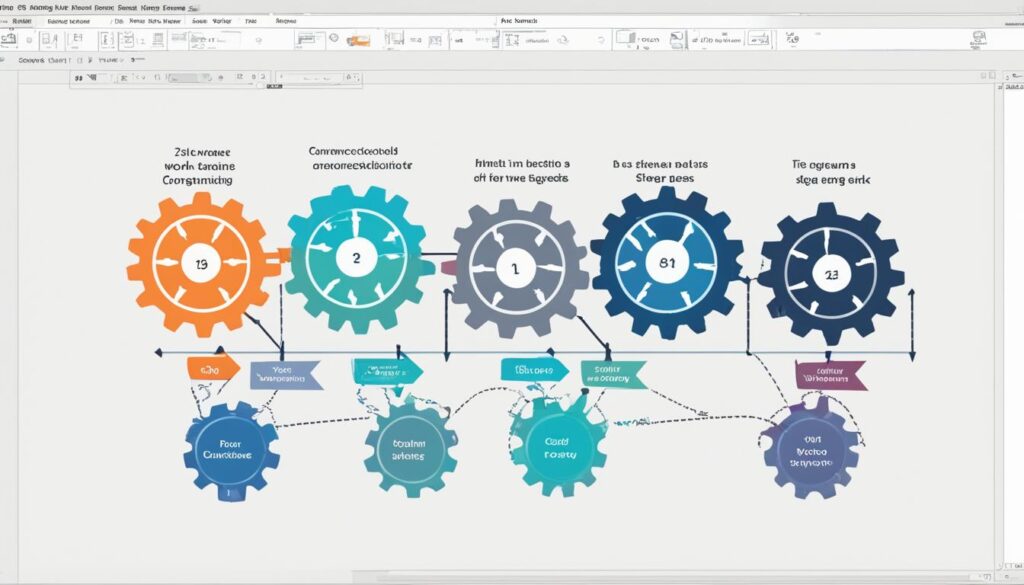As a data analysis tool, Tableau offers powerful capabilities for visualizing and interpreting data. However, to maximize its potential, organizations need to implement effective workflow management practices. Workflow management for Tableau data analysis involves designing a structured and efficient process for data extraction, transformation, and visualization. By automating repetitive tasks, defining clear data sources, and establishing standardized guidelines for data cleansing and validation, organizations can save time, reduce errors, and ensure consistency in their data analysis processes.
Table of Contents
ToggleKey Takeaways:
- Workflow management is essential for efficient and streamlined Tableau data analysis.
- Automation plays a crucial role in saving time and reducing errors in the data analysis process.
- Clear data sources and standardized guidelines ensure consistency in data analysis.
- Workflow management in Tableau can help organizations gain valuable insights and make informed decisions.
- Implementing a proper workflow management system improves efficiency and effectiveness in data analysis.
The Modern Analytics Workflow
The Modern Analytics Workflow is a framework within Tableau Blueprint that enables individuals to ask and answer their own questions with data. It consists of five key actions: Access & View, Interact, Analyze & Discover, Share, and Promote & Govern.
IT and/or BI Professionals play a role in managing and maintaining the Tableau deployment, while Content Creators are responsible for creating content. Information Consumers, such as Tableau Viewers, access and interact with the content.
Access & View
- Access and connect to data sources
- View and explore existing dashboards and reports
Interact
- Interact with visualizations, filter data, and drill down into details
- Ask and answer questions in real-time
Analyze & Discover
- Analyze data using various tools and techniques
- Discover insights, patterns, and trends
Share
- Share dashboards, reports, and visualizations with others
- Collaborate and communicate findings
Promote & Govern
- Promote the use of Tableau within the organization
- Establish governance policies and standards for data analysis
- Ensure data security and compliance
By following the Modern Analytics Workflow, organizations can empower their teams to make data-driven decisions and derive valuable insights from their data.
Steps to Set Up Tableau Workflow
To set up a Tableau Workflow, follow these three steps:
-
Initialize Prep Builder in Workflow
In Prep Builder, you can start a new flow, open an existing flow, or use sample flows as a reference.
-
Manage Your Data in Workflow
Connect to data sources, upload static files, or fetch data from Tableau Server. Monitor flow creation and clean and prepare the data.
-
Add Steps to the Workflow Task
Use various flow steps, such as cleaning, aggregating, pivoting, joining, and scripting, to manipulate the data. Save the output as a .csv or .hyper file.
Example of a Tableau Workflow
In this section, I will provide an example of a Tableau Workflow to give you a clear understanding of how it works in practice. The example I will be discussing is the Superstore Flow, which involves cleaning and combining data from different geographies, performing operations like Union and Join, and creating output files.
The Superstore Flow starts with cleaning the raw data to ensure its accuracy and consistency. This step involves removing duplicates, formatting dates, and handling missing values. By cleaning the data, we can eliminate any inconsistencies that may affect the accuracy of our analysis.
Once the data is cleaned, we move on to combining data from different geographies. This step allows us to analyze the performance of our Superstore across different regions or countries. For example, we can combine the sales data from the United States, Europe, and Asia to gain a comprehensive view of our global operations.
To perform the data combination, we utilize operations like Union and Join. Union allows us to stack similar datasets on top of each other, while Join allows us to combine datasets based on common fields. These operations help us consolidate the data from different sources into a single dataset for further analysis.
After combining the data, we can perform additional operations to derive more insights. This may include aggregating the data to calculate summary statistics, pivoting the data to transform its structure, or scripting custom calculations to perform complex analyses. Each step in the workflow can be customized to suit our specific analytical needs.
Finally, we create output files to share our analysis with stakeholders or use them for further analysis in other tools. The output files can be in formats like CSV or Tableau Data Extract (TDE), depending on our requirements.
To summarize, the Superstore Flow example demonstrates the power and versatility of Tableau workflows in managing and analyzing data. It showcases how we can clean, combine, and manipulate data to derive valuable insights. The flexibility of Tableau workflows allows us to customize each step according to our data analysis needs, empowering us to make informed decisions and drive business impact.
| Workflow Steps | Description |
|---|---|
| Data Cleaning | Remove duplicates, format dates, handle missing values |
| Data Combination | Combine data from different geographies |
| Union and Join | Stack similar datasets and combine based on common fields |
| Additional Operations | Aggregating, pivoting, scripting |
| Create Output Files | Save analysis results in CSV or TDE format |
Automating Tableau Workflows
Automating Tableau Workflows is a game-changer for organizations looking to streamline their data analysis processes. With the help of Tableau Prep Conductor, it is now possible to automate repetitive tasks and ensure that your workflows run efficiently without manual intervention.
One of the key methods to automate Tableau Workflows is through scheduling. By setting up a schedule, you can specify fixed intervals at which your workflows should run. Whether it’s daily, weekly, or monthly, scheduling allows you to automate the execution of your workflows, saving you time and effort.
Another way to automate Tableau Workflows is by leveraging REST APIs. REST (Representational State Transfer) APIs enable you to trigger workflows programmatically, integrating them with other systems or applications. By using REST APIs, you can initiate workflows based on specific events or triggers, ensuring that your data analysis processes are seamlessly integrated into your existing infrastructure.
Automation not only saves time but also enhances the accuracy and consistency of your data analysis. By eliminating the need for manual intervention, you reduce the risk of human errors and ensure that your workflows are executed reliably.
With automated Tableau Workflows, you can generate updated outputs as your data changes. This ensures that your insights are always up to date and relevant, enabling you to make informed decisions based on the most recent data.
To give you a visual representation, here is an example of how automating Tableau Workflows can benefit your organization:
Imagine a scenario where you regularly receive data updates from multiple sources. In the past, you would have had to manually download and import these datasets into Tableau, run the necessary data transformations, and update your visualizations. This process was time-consuming and prone to errors.
Now, with automating Tableau Workflows, you can set up a schedule to automatically fetch the data from the sources, run the required transformations, and update your visualizations on a regular basis. This ensures that your insights are always based on the most up-to-date data, allowing you to make data-driven decisions with confidence.
Automating Tableau Workflows through scheduling and REST APIs is a powerful capability that enhances the efficiency, accuracy, and consistency of your data analysis process. By leveraging Tableau Prep Conductor, you can automate repetitive tasks, ensure timely updates, and focus on deriving insights from your data.
Next, let’s explore an example of a Tableau Workflow to further illustrate the benefits of automation.
What Makes Hevo’s ETL Process Best-In-Class
Hevo offers a best-in-class ETL (Extract, Transform, Load) process that sets it apart from competitors in the market. As a fully managed, no-code platform, Hevo automates and simplifies the data replication process, making it effortless for organizations to extract, transform, and load their data.
One of the key features of Hevo’s ETL process is its seamless data replication capability. Hevo supports data extraction from over 100 data sources, allowing users to easily fetch data from various systems and databases. This comprehensive coverage ensures that organizations can access all their necessary data without any hassle or limitations.
Furthermore, Hevo’s ETL process excels in data transformation. With intuitive and powerful data transformation capabilities, organizations can manipulate and enrich their data before loading it into their target systems. This flexibility enables users to cleanse, aggregate, and restructure their data according to their specific requirements, ensuring high-quality and relevant insights.
“Hevo’s ETL process allows organizations to streamline their data analysis, making the journey from raw data to actionable insights faster and more efficient.”
Another notable aspect of Hevo’s ETL process is its ability to facilitate faster insight generation. By eliminating manual data replication and transformation tasks, Hevo significantly reduces the time taken to generate insights. This speed is crucial in today’s fast-paced business environment, where real-time decision-making is of utmost importance.
Additionally, Hevo’s ETL process offers robust schema management capabilities. Organizations can easily manage their data schemas, ensuring consistency and compatibility across different systems and databases. This streamlined schema management saves time and effort, allowing organizations to focus on data analysis rather than schema maintenance.
In summary, Hevo’s ETL process stands out as a best-in-class solution due to its seamless data replication, powerful data transformation, faster insight generation, and efficient schema management capabilities. With Hevo, organizations can optimize their data analysis workflows, unlock valuable insights, and drive data-powered decision-making.
Steps to Set Up Tableau Workflow
To set up a Tableau Workflow, follow these three steps:
Step 1: Initialize Prep Builder in Workflow
Start a new flow, open an existing flow, or use sample flows as reference to begin building your workflow using Prep Builder. This intuitive tool allows you to visually design the flow and define the sequence of steps.
Step 2: Manage Your Data in Workflow
Connect to your desired data sources, whether it’s databases, spreadsheets, or online services. Upload static files or fetch data directly from the Tableau Server. Use the features in Workflow to monitor flow creation and ensure that your data is clean and prepared for analysis. Seamlessly integrate, blend, and transform your data to fit your analytical needs.
Step 3: Add Steps to the Workflow Task
Enhance your workflow by adding steps to manipulate and shape your data. Utilize various flow steps, such as cleaning, aggregating, pivoting, joining, and scripting, to transform your data into a format that is optimal for analysis. Leverage these capabilities to generate meaningful insights and actions. Finally, save the output as a .csv or .hyper file for further analysis or sharing with others.
By following these steps, you can effectively set up and customize a Tableau Workflow that meets your specific data analysis requirements, enabling you to streamline and enhance your data-driven decision-making process.
Please note that the following table illustrates the available flow steps that can be added to the Workflow Task:
| Flow Step | Description |
|---|---|
| Cleaning | Remove irrelevant or duplicate data, apply filters, or fix data quality issues. |
| Aggregating | Group and summarize data to obtain aggregated insights and metrics. |
| Pivoting | Restructure data by rotating rows into columns or vice versa for better analysis. |
| Joining | Combine different data sources by matching common fields to create a consolidated dataset. |
| Scripting | Apply custom calculations, transformations, or advanced data manipulation using scripting languages. |

What is Workflow Analytics and How Helpful It Is?
Workflow analytics is a powerful tool for businesses to analyze and measure the efficiency and effectiveness of their workflows. By collecting and analyzing data related to each step and task within a workflow, organizations can gain valuable insights into the performance of their processes. These insights help in identifying bottlenecks, inefficiencies, and areas of improvement, allowing businesses to make informed decisions to optimize and streamline their operations.
One of the key benefits of workflow analytics is the ability to collect and analyze data. By leveraging data analysis techniques, businesses can extract valuable information from their workflows, enabling them to gain a deeper understanding of their processes. This data-driven approach provides valuable insights into how workflows are functioning and allows organizations to identify patterns and trends that can lead to actionable improvements.
Workflow analytics empowers organizations to predict future workflow outcomes and make proactive adjustments
Identifying patterns and trends is another crucial aspect of workflow analytics. By analyzing historical data, organizations can identify recurring patterns and trends within their workflows. This analysis enables businesses to anticipate future workflow outcomes and make proactive adjustments. Whether it’s identifying seasonal fluctuations in workflow performance or uncovering trends that impact efficiency, these insights are invaluable in guiding decision-making and driving operational improvements.
In conclusion, workflow analytics is a data analysis approach that enables businesses to collect, analyze, and gain valuable insights from their workflows. By leveraging data and identifying patterns and trends, organizations can optimize their processes, improve efficiency, and make informed decisions. Workflow analytics is an essential tool for any business seeking to drive continuous improvement and maximize the impact of their operations.
Example of Workflow Analytics in Action
To illustrate the power of workflow analytics, consider the following example:
| Workflow Stage | Key Metrics | Insights |
|---|---|---|
| Data Collection | Time taken to collect data from various sources | Data collection from external sources is time-consuming, delaying the overall workflow |
| Data Processing | Number of errors encountered during data processing | High error rate indicates a need for improved data validation and cleansing processes |
| Data Analysis | Time taken to generate insights and actionable recommendations | Long analysis time suggests the need for more efficient analytical techniques |
In this example, workflow analytics identified specific areas of improvement within each stage of the workflow. By addressing these insights, the organization was able to streamline their data collection, processing, and analysis processes, resulting in improved efficiency and better decision-making.
What is Tableau?
Tableau is a data visualization and business intelligence platform that revolutionizes the way organizations analyze and understand their data. As a powerful tool, Tableau allows users to connect to various data sources, including spreadsheets and databases, and create interactive and dynamic visualizations, reports, and dashboards.
With its intuitive and user-friendly interface, Tableau empowers users to easily explore and visualize data from multiple sources, uncovering valuable patterns and insights that drive informed decision-making. Whether it’s exploring sales trends, analyzing customer behavior, or understanding market dynamics, Tableau equips users with the visual tools needed to interactively explore and communicate data.
Key Features of Tableau:
- Connect to Data: Tableau enables users to seamlessly connect to a wide range of data sources, such as spreadsheets, databases, and cloud services.
- Data Visualization: Tableau provides a rich set of visualization options, allowing users to create interactive charts, graphs, maps, and more.
- Reports and Dashboards: Tableau empowers users to design comprehensive reports and interactive dashboards that can be shared with stakeholders.
- Data Blending: With Tableau, users can combine and blend data from different sources to gain a holistic view of their business.
Tableau is not just a tool for data visualization; it is a complete business intelligence platform that enables organizations to harness the power of their data. By leveraging Tableau’s features and functionalities, businesses can uncover hidden insights, identify trends, and make data-driven decisions that propel them forward.

| Benefits of Tableau | Benefits of Tableau |
|---|---|
| Interactive and Dynamic Visualizations | Data Exploration and Analysis |
| Efficient Data Reporting | Collaborative Data Sharing |
| Actionable Insights and Decision-making | Scalability and Flexibility |
What Does Tableau Do?
Tableau is an incredibly powerful and versatile data analysis tool that offers a wide range of capabilities to help users make sense of their data. With Tableau, you can connect to various data sources, perform in-depth data analysis, and create stunning visualizations to communicate insights effectively.
Here are some key features and functionalities that Tableau provides:
- Data Analysis: Tableau allows you to explore and analyze your data from multiple angles, uncovering patterns, trends, and outliers.
- Connect to Data: With Tableau, you can easily connect to different data sources, such as databases, spreadsheets, and cloud services, enabling you to work with all your data in one place.
- Visualization: Tableau offers a rich set of visualization options, including charts, graphs, maps, and more. You can create interactive dashboards that allow users to interact with the data and gain valuable insights.
- Data Blending: Tableau enables you to blend data from different sources, bringing together disparate datasets to create a unified view and uncover new insights.
- Forecasting: Tableau provides advanced analytics capabilities, allowing you to forecast future trends based on historical data. This feature is particularly useful for making informed business decisions and planning for the future.
- Geographical Mapping: With Tableau’s geographical mapping capabilities, you can plot data on maps and visualize spatial relationships. This is especially valuable for analyzing location-based data and understanding geographic patterns.
Tableau’s intuitive interface and user-friendly design make it accessible to users of all skill levels, from beginners to advanced analysts. Whether you’re a data analyst, business user, or executive, Tableau empowers you to explore, analyze, and present data in a visually compelling and actionable way.
| Feature | Description |
|---|---|
| Data Analysis | Explore and analyze data from multiple angles, uncovering patterns, trends, and outliers. |
| Connect to Data | Easily connect to different data sources, such as databases, spreadsheets, and cloud services. |
| Visualization | Create interactive and visually appealing dashboards, charts, graphs, and maps. |
| Data Blending | Combine data from different sources to create a unified view and gain new insights. |
| Forecasting | Predict future trends based on historical data. |
| Geographical Mapping | Plot and analyze data on maps to understand spatial relationships and geographic patterns. |
What’s Included in Tableau?
Tableau offers a comprehensive set of features and functionalities to support data analysis and visualization. With its robust toolkit, users can effortlessly create interactive visualizations, leverage powerful data preparation tools, connect to various data sources, and collaborate and share insights with colleagues. Let’s explore some of the key components included in Tableau:
Data Visualization Capabilities
Tableau provides a wide range of data visualization capabilities, enabling users to transform raw data into meaningful and engaging visual representations. With Tableau, you can create interactive charts, maps, and tables that allow for in-depth exploration of your data.
Data Preparation Tool
Efficient data preparation is a crucial step in the data analysis process. Tableau offers a robust data preparation tool that allows users to clean, transform, and reshape their data effortlessly. This tool streamlines the process and ensures that your data is in the optimal format for analysis.
Data Connectivity Options
Tableau offers seamless connectivity to various data sources, enabling users to access and analyze data from multiple platforms. Whether it’s connecting to databases, spreadsheets, or cloud-based solutions, Tableau provides the flexibility to connect to diverse data sources and consolidate information in one centralized location.
Collaboration and Sharing Features
Collaboration is key to driving impactful insights within organizations. Tableau provides robust collaboration and sharing features that allow users to share reports, workbooks, and data sources with their colleagues. This fosters collaboration, encourages knowledge sharing, and ensures that insights reach the right stakeholders.
Tableau in Action
To illustrate the power of Tableau’s features, take a look at the following example:
| Data Visualization | Data Preparation | Data Connectivity | Collaboration and Sharing |
|---|---|---|---|
| Create interactive visualizations | Clean and transform data | Connect to various data sources | Share reports and insights |
 |
 |
As you can see, Tableau empowers users with a powerful suite of tools to visualize and analyze data, making it a valuable asset for businesses across industries.
Conclusion
In conclusion, workflow management is essential for efficient and streamlined data analysis in Tableau. By implementing a structured workflow and utilizing the features and functionalities of Tableau, organizations can enhance their data analysis processes and gain valuable insights. With automation and proper workflow management, Tableau becomes a powerful tool for analyzing and visualizing data, helping businesses make informed decisions and drive impact.
Workflow management enables organizations to save time by automating repetitive tasks and ensuring consistency in the data analysis process. It also reduces errors and improves accuracy by establishing clear data sources and standardized guidelines for data cleansing and validation. By following a well-defined workflow, organizations can optimize their Tableau data analysis and achieve better outcomes.
In addition, implementing Tableau’s Modern Analytics Workflow framework provides individuals with the ability to ask and answer their own questions with data. The framework includes actions such as accessing and viewing data, interacting with it, analyzing and discovering insights, sharing findings, and promoting and governing the data. This framework empowers users to explore and visualize data in a self-service manner, promoting a data-driven culture within organizations.
Overall, with its powerful features, versatility, and user-friendly interface, Tableau is a valuable tool for data analysis and visualization. By leveraging proper workflow management and automation, businesses can harness the full potential of Tableau, unlocking actionable insights and driving growth in today’s data-driven world.
FAQ
What is workflow management for Tableau data analysis?
Workflow management for Tableau data analysis involves designing a structured and efficient process for data extraction, transformation, and visualization. It includes automating repetitive tasks, defining clear data sources, and establishing standardized guidelines for data cleansing and validation.
What is the Modern Analytics Workflow in Tableau?
The Modern Analytics Workflow is a framework within Tableau Blueprint that enables individuals to ask and answer their own questions with data. It consists of five key actions: Access & View, Interact, Analyze & Discover, Share, and Promote & Govern.
How can I set up a Tableau Workflow?
To set up a Tableau Workflow, follow these three steps: 1) Initialize Prep Builder in Workflow, 2) Manage Your Data in Workflow, and 3) Add Steps to the Workflow Task.
Can you provide an example of a Tableau Workflow?
An example of a Tableau Workflow involves the Superstore flow. The flow includes cleaning and combining data from different geographies, performing operations like Union and Join, and creating output files.
How can Tableau Workflows be automated?
Tableau Workflows can be automated using Tableau Prep Conductor. Automation can be set up through scheduling, where workflows run at fixed intervals, or by using REST APIs to trigger workflows.
What makes Hevo’s ETL process best-in-class?
Hevo offers a best-in-class ETL (Extract, Transform, Load) process. It is a fully managed, no-code platform that automates and simplifies the data replication process. With features like schema management and real-time data replication, Hevo enables faster insight generation and streamlined data analysis.
What is workflow analytics and how helpful is it?
Workflow analytics involves analyzing and measuring the efficiency and effectiveness of a business workflow. It helps in collecting and analyzing data related to the various steps and tasks involved in a workflow to identify bottlenecks, inefficiencies, and areas of improvement.
What is Tableau?
Tableau is a data visualization and business intelligence platform that allows users to connect to various data sources, such as spreadsheets and databases, and create interactive and dynamic visualizations, reports, and dashboards.
What does Tableau do?
Tableau is a versatile data analysis tool that allows users to connect to various data sources, analyze data, and create visualizations. Tableau enables users to combine different datasets, perform calculations and aggregations, and create interactive visualizations such as charts, graphs, and maps.
What’s included in Tableau?
Tableau includes a range of features and functionalities for data analysis and visualization. It provides data visualization capabilities, a data preparation tool for cleansing and transforming data, data connectivity options, and collaboration and sharing features.











